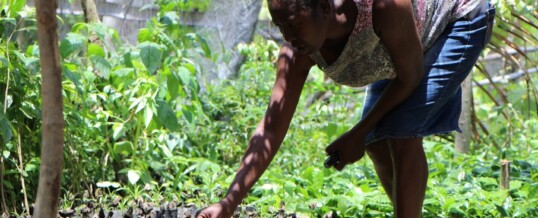
How Haiti and Canada can turn the urban exodus into an opportunity to decentralize and build a sustainable future for Haitians
McLeod Group guest blog by Mary Durran, February 3, 2025
They flee the Port-au-Prince neighbourhoods that were once hubs bustling with traders, schoolchildren and colourful tap-tap taxis: women who have stuffed their lives into bust-up old suitcases piled on their heads and faded pillowcases stuffed full of clothes. Some don’t even have time to grab their meagre belongings before fleeing the terror of gangs such as Viv Ansamn (Living Together) that invade residential areas. They risk their lives, either making the dangerous journey through gang-controlled territory on the road that leads south out of Port-au-Prince, or they navigate the slippery and sinuous mountain paths between Kenscoff and Jacmel on a motorbike taxi, each route costing more than four times what it used to before the gangs gained a stranglehold on the capital.
Over one million Haitians – nearly 9% of the population – have fled Port-au-Prince, as the gangs continue their rampage of kidnapping, arson, raping women and girls and robbing the population. Some inhabitants of the capital have stayed in under-resourced urban shelters, but 75% of displaced people have relocated to rural communities, especially along the south coast, where food is scarce but they can shelter in the relative calm of family members’ modest homes.
Canada’s aid program in Haiti needs to consider this urban exodus an opportunity to support long overdue decentralization and programs that encourage the displaced to stay in the rural regions. Most might prefer to continue to viv andeyo, Creole for living outside the capital city, and never to return to the overcrowded, insalubrious and impoverished urban neighbourhoods where snarling traffic jams turn work or school commutes into hours-long torment and sicken people with noxious fumes.
For instance, Development and Peace – Caritas Canada supports two projects with two grassroots community organizations that work with displaced families on the southern coast. Women fleeing gender-based violence often knock first on the door of Fanm Deside (Determined Women), a women’s organization in the southeastern city of Jacmel. With Canadian support, Fanm Deside provides medical consultations and orientation to displaced women, and then a small amount of cash to enable them to travel on to join their relatives in rural communities. The organization is also raising awareness about and evoking solidarity with the displaced among local women.
Further west along the coast, in Cavaillon, the families who were first hit by Hurricane Matthew in 2016 and then by a powerful earthquake in 2021, are welcoming the displaced into their already crowded homes while struggling to put food on the table. Development and Peace – Caritas Canada is helping the Institute for Technology and Animation provide seeds and farming tools to allow them to grow beans, yams and vegetables.
Unfortunately, such small-scale initiatives will not be enough to sustain these families over the medium to long term. In order to provide an incentive for people to stay in rural regions once the grip of the gangs loosens, the Haitian government needs to invest more in agricultural production, health and education services, and police presence in the rural areas. Canada should encourage the Ministry of Agriculture, Natural Resources and Rural Development to bolster its presence in regional departments by investing in developing its local offices, training local personnel, paying them regularly and equipping them to support local farming initiatives.
Canada and international NGOs should also strengthen community groups to enable them to work with the local authorities to help provide these services. And more aid is necessary. Last year, only 43.5% of the UN’s humanitarian appeal of US$674 million was raised, with the Canadian contribution of US$4.7 million accounting for just 1.6% of the total required.
It is very effective and low-cost to work with rural grassroots community groups whose modus operandi is consultation and who have the best in-depth knowledge of communities and their needs. Such an approach fosters local pride and motivates Haitians to tackle their own issues, instead of promoting “assistanat et assistentialisme,” as a Haitian colleague called the passivity encouraged by the wasteful and haphazard handouts that characterized mismanaged aid following the 2010 earthquake. It is also coherent with the ownership principle of the Paris Declaration on Aid Effectiveness.
As long as young people living in abject poverty in densely populated slums in Port-au-Prince and other cities have no viable opportunities and face a bleak future, they will remain vulnerable to recruitment by gangs, especially if the gangs keep being funded by wealthier Haitians. At least part of the solution lies in providing incentives to more youths to stay in Haiti’s rural areas whilst also improving food security by investing in agriculture and facilitating small businesses that sell produce.
As Pope Francis states in his papal exhortation Evangelii Gaudium, “until exclusion and inequality in society and between peoples are reversed, it will be impossible to eliminate violence.”
Mary Durran is a program officer for Haiti for Development and Peace – Caritas Canada. Photo: Institut de Technologie et d’Animation, Haiti.
